Subtitle: How we created and played a brand new game all in one day.
On Day 2 of DeepAgile, Michael McCollough and Don McGreal got us started on with a game design workshop. From there we used open space to invent and play the game with other attendees. This blog shares what we learned about product backlogs and game design.
Getting started: A room with a view

The first job in open space was to create 3 consecutive session in the open space (one for each of: objectives, design and play – see photo). I announced that each open space session was independent and that people could attend just one or all – we would do a re-start at the beginning of each one. Working and collaborating with others – what a great way to use Open Space.
I scoped out an amazing room at NERD with a round table, ceiling-height whiteboard and a spectacular view. Perfect for inspiring a team and encouraging collaboration.
Learning Objectives: Keep it simple
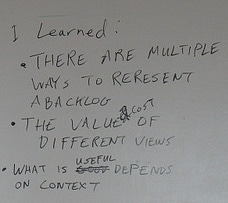
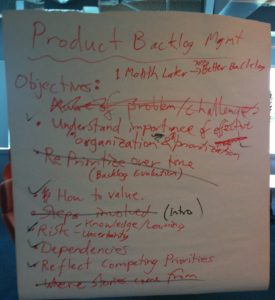 We started with a long list of learning objectives at the end of Mike & Don’s workshop (see photo on left). We knew this was way too long and had it winnowed down to the three within the next hour (see photo on right). By the end of the day we had stripped it down even further to just the first objective: there are multiple ways to represent a backlog. KISS strikes again.
We started with a long list of learning objectives at the end of Mike & Don’s workshop (see photo on left). We knew this was way too long and had it winnowed down to the three within the next hour (see photo on right). By the end of the day we had stripped it down even further to just the first objective: there are multiple ways to represent a backlog. KISS strikes again.
The Problem: Product Backlog Management has challenges
The starting place was to help product owners to organize and prioritize their backlog. We spent discussed the topic for a while to get on the same page. We figured out there are a whole bunch of steps involved in building and maintaining a backlog (See diagram below):
- Identify Stakeholders
- Identify work (Stories)
- Estimate work (units, T-Shirt sizes); identify risks
- Organize & Prioritize <– Focus of our game is on organizing
- Communicate
- Execution & tracking (Release burndown/up)
- Re-prioritize
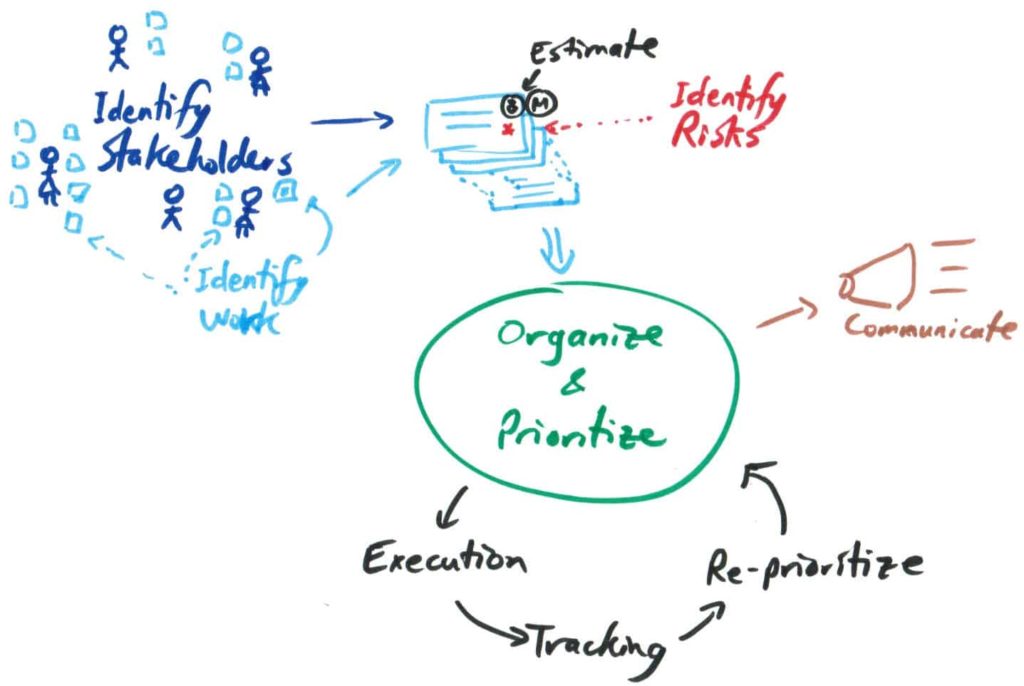
(We had a great diagram on the whiteboard but can’t find it. So I redrew it from memory and added some flourishes.)
The simple act of preparing brainstorming objectives for the game led to a better understanding for all of us on the full life cycle of a product backlog. The big picture allowed us to focus in on one part: organizing and prioritizing. Even this was too big! We split approaches and concepts into ones that were more about organizing and ones more about prioritizing. At this point we had three game concepts:
- The missing stakeholder game – who are my stakeholders and why are the missing? (prioritization)
- “Malfunction at the stakeholder junction” – AKA the dysfunctional stakeholder game. “I want this.” “No, I want this.” (prioritization)
- The Backlog is in the eye of the beholder – all about organizing based different stakeholder perspectives. (organization)
We did a strawman vote and there was a clear consensus around moving forward with the last one – on organization of the backlog.
Working together on the game
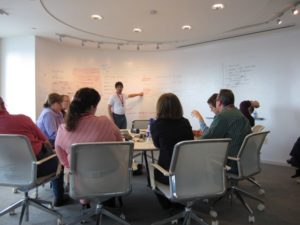 It was fun. Really fun. I played the role of product champion and facilitator.
It was fun. Really fun. I played the role of product champion and facilitator.
We started with the Pomodoro Technique to stay focussed and on track (yes, I even drew tomatoes on the whiteboard). In the design session, we got into a state of flow and just kept going to meet our timebox.
We had to deliver a game since it was announced and on the open space board! As my thesis supervisor said – “Nothing concentrates the mind like a deadline.”
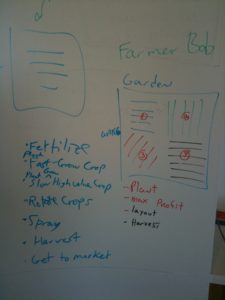
We did lot’s of brainstorming. Everyone was really good about coming up with ideas and letting go of ones that weren’t working out. One idea Greg Ott came up with was that of a garden (see photo on right). After a while this turned into the the farm metaphor we decided to use for the game. In retrospect, having a huge wall to keep ideas alive was invaluable.
Playing the Game
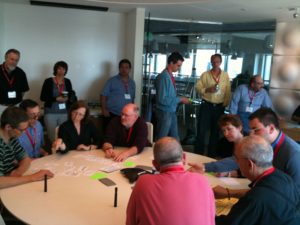
Playing the game was a lot of fun. You could feel the energy in the air (see photo) and the room was packed with designers, players, and observers. We got mostly very positive reviews.
You can find the game rules and feedback here: Backlog is in the Eye of the Beholder Game v0.7 This is our current version. It is also posted on TastyCupcakes game site. Feel free to use and make your own.
Thanks to everyone who designed, played and supported us. Special thanks to core co-inventors: Warren Elliott, Greg Ott, Mary Gorman, Dan Zaino, Judy Rivais.
(This is part of a series on DeepAgile 2010 Games Weekend).


